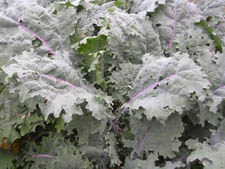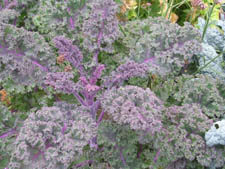Kale is an old-fashioned vegetable that's been enjoying a revival of late. Not only is it loaded with nutrients and easy to grow, newer varieties make attractive landscape addition to any flower or vegetable garden.
If you were going to eat only one vegetable for your health, kale should be it. Kale is loaded with calcium, iron, and Vitamins A, C, and K. Also, it has phytonutrients such as sulforaphane and indoles, which may help protect us from cancer.
This non-heading cabbage comes as a flat or curly leaf with stem colors ranging from dark green to burgundy. In fall, ornamental kale varieties are sold at garden centers. While these are edible, they are mostly grown for their showy colors. There are tastier edible varieties available that are just as attractive, especially once touched by some cold weather.
Here are the basics of kale growing.
PlanningKale is a cool-season cabbage-family crop that grows best in spring, fall, or winter, depending on your location. It's actually a biennial grown as an annual. The leaf color and sweetness of all varieties intensifies with the cold. Depending on your location, kale can overwinter to yield fresh greens in early spring.

'Red Russian' kale has flat leaves with beautiful red veins. Young leaves are tender enough to be eaten raw in salads.
There are a number of different varieties to try that are attractive and productive. Here are some of my favorites.
Lacinata- Also called dinosaur kale, it features blue-green, puckered, lance-shaped leaves on 2- to 3-foot-tall, palm tree-like plants. It contains higher amounts of phytonutrients than other varieties and is great cooked in soups and stews.
'Nagoya hybrid'- This variety is used more as an ornamental kale than as an edible, but it still can be eaten. It has frilly, green outer leaves and rose to white-colored center leaves on 1-foot-tall plants.
'Red Bor Hybrid'- Probably the most attractive of the kale varieties, its frilly, blue-green leaves have red veins and stems on 3- to 4-foot-tall plants. The red color becomes more pronounced with cold weather, and leaves have a purple tinge.
'Red Russian'- This variety has large, flat, blue-green leaves with purple stems on 2- to 3-foot-tall plants. The leaves are more tender than frilly varieties and are good raw in salads as well as cooked.
'Dwarf Blue Curled Scotch'- This is a classic frilly variety that only grows 1 to 2 feet tall at maturity.
'White Russian'- This flat-leafed variety is similar to 'Red Russian' but has white stems and veins, is a little taller, and is more productive. It is one of the most cold hardy kales, surviving winter temperatures to 0 degrees without protection.
'Winterbor'- These 2- to 3-foot tall plants produce high yields of curly, blue-green leaves. The plant has good cold tolerance.

'Redbor' kale features red stems and leaf veins that turn purplish-red with colder weather.
Kale grows best in full to part sun on well-drained soils high in organic matter. Amend the soil with a 1/2-inch-thick layer of compost before planting. Plant kale with other cool temperature-loving flowers and vegetables, such as Swiss chard, mustard, asters, chrysanthemums, and pansies.
PlantingPlant kale in spring, one month before your last frost date for a summer harvest. Plant again six weeks before your first frost date in fall for autumn and early winter harvest. In warm climates, fall plantings will grow through the winter for an early spring harvest before they flower. Sow seeds 1/2 inch deep and 1 inch apart. You can also start seeds indoors. When they are four weeks old, transplant seedling 6 inches apart, in rows 2 to 3 feet apart, and thin to 12 inches apart when leaves begin to touch.
CareUnless the leaves look yellow, applying additional fertilizer is usually not necessary. For a quick boost of nitrogen on poor soils, fertilize with fish emulsion when seedlings are 4 inches tall. Mulch established plants with a 2- to 3-inch-thick layer of hay, grass clippings, or leaves to conserve moisture, keep the soil cool, and prevent weed growth. Kale has only a few insect pests of concern.
To control aphids, spray with insecticidal soap. To control cabbageworms and cabbage loopers, cover plants with a floating row cover or spray with Bacillus thuringiensis (Bt). This organic biological pesticide controls the caterpillars without harming wildlife, beneficial insects, pets, or humans.
HarvestHarvest baby greens for salads one month after planting. Plants mature 50 to 70 days after seeding. In the center of mature plants, harvest tender young leaves for use in salads. Wait until cooler weather arrives to harvest older leaves for cooking. The flavor sweetens with cold weather.
Other Great Kale Stories Charlie Nardozzi is an award winning, nationally recognized garden writer, speaker, radio, and television personality. He has worked for more than 30 years bringing expert gardening information to home gardeners through radio, television, talks, tours, on-line, and the printed page. Charlie delights in making gardening information simple, easy, fun and accessible to everyone. He's the author of 6 books, has three radio shows in New England and a TV show. He leads Garden Tours around the world and consults with organizations and companies about gardening programs. See more about him at Gardening With Charlie.
Charlie Nardozzi is an award winning, nationally recognized garden writer, speaker, radio, and television personality. He has worked for more than 30 years bringing expert gardening information to home gardeners through radio, television, talks, tours, on-line, and the printed page. Charlie delights in making gardening information simple, easy, fun and accessible to everyone. He's the author of 6 books, has three radio shows in New England and a TV show. He leads Garden Tours around the world and consults with organizations and companies about gardening programs. See more about him at Gardening With Charlie.
 Victory Seed Company has all the seeds you want for your best garden in 2024.
Victory Seed Company has all the seeds you want for your best garden in 2024.
For 25 years, the family-owned Victory Seed Company has provided the highest quality vegetable, herb and flower seeds to families across the country. We are passionate about providing you the best seeds available that give excellent germination, robust plants, and the harvest you want. With a catalog of over a thousand varieties, we have everything, and our prices are the kinds that we'd want to pay. We have hundreds of yesterday's heirloom vegetables, as well as today's award winning hybrid selections. Get to know us by visiting our website and browsing through our online vegetable seed catalog.